Pasta Carbonara: just the name conjures up images of creamy, decadent comfort food, doesn’t it? Forget complicated sauces and hours in the kitchen; this classic Italian dish is surprisingly simple to make, yet delivers a flavor explosion that will have you craving more. Have you ever wondered how such a humble combination of ingredients could create such a beloved culinary masterpiece?
While the exact origins of pasta carbonara are debated, many believe it emerged in Rome during or shortly after World War II. Some theories suggest it was created to satisfy American soldiers’ cravings for bacon and eggs, using readily available ingredients like eggs, bacon (or pancetta), and pasta. Regardless of its precise history, carbonara has become a staple of Roman cuisine and a global favorite.
What makes carbonara so irresistible? It’s the perfect marriage of textures and tastes. The silky, rich sauce, created by the emulsification of egg yolks, Pecorino Romano cheese, and starchy pasta water, clings beautifully to the al dente pasta. The salty, savory pancetta (or bacon) adds a delightful crunch and smoky depth, while a generous grind of black pepper provides a subtle kick. It’s quick, satisfying, and undeniably delicious a true testament to the beauty of simple, high-quality ingredients. So, let’s dive in and learn how to make authentic pasta carbonara that will impress your family and friends!
Ingredients:
- 1 pound spaghetti
- 6 ounces guanciale, pancetta, or bacon, cut into 1/4-inch dice
- 4 large eggs
- 1 cup grated Pecorino Romano cheese, plus more for serving
- 1/2 cup grated Parmesan cheese
- Freshly ground black pepper, to taste
- Salt, to taste (be mindful of the saltiness of the guanciale/pancetta/bacon)
- 2 tablespoons olive oil (optional, if guanciale/pancetta/bacon is lean)
Preparing the Guanciale (or Pancetta/Bacon):
Okay, let’s start with the heart of the carbonara the cured pork! Whether you’re using guanciale (the most authentic choice!), pancetta, or bacon, the preparation is pretty much the same. The goal is to render the fat and get it nice and crispy.
- Dice the Pork: If you haven’t already, cut your guanciale, pancetta, or bacon into 1/4-inch dice. Uniformity is key for even cooking.
- Render the Fat: Place the diced pork in a large skillet or Dutch oven over medium heat. If your pork is particularly lean (some bacon can be!), you might want to add a tablespoon or two of olive oil to the pan to get things started. Otherwise, the pork should render enough fat on its own.
- Cook Until Crispy: Cook the pork, stirring occasionally, until it’s golden brown and crispy. This usually takes about 8-12 minutes, depending on the heat and the type of pork you’re using. Be careful not to burn it! Burnt pork will make your carbonara taste bitter.
- Reserve the Fat: Once the pork is crispy, remove it from the pan with a slotted spoon and set it aside. Don’t discard the rendered fat in the pan! This is liquid gold and will add incredible flavor to your carbonara. If there’s a *lot* of fat, you can pour off some of it, leaving about 2-3 tablespoons in the pan.
Preparing the Egg and Cheese Mixture:
This is where the magic happens! The creamy sauce in carbonara comes from the emulsification of the egg yolks, cheese, and pasta water. It’s crucial to get this right to avoid scrambled eggs in your pasta!
- Separate the Eggs: In a medium bowl, separate the yolks from the whites of the 4 large eggs. You only need the yolks for this recipe. You can save the whites for an omelet or meringue later.
- Grate the Cheese: Grate 1 cup of Pecorino Romano cheese and 1/2 cup of Parmesan cheese. Pecorino Romano is the traditional choice and has a sharper, saltier flavor than Parmesan. Using a combination of both adds complexity.
- Combine the Cheese and Yolks: Add the grated Pecorino Romano and Parmesan cheese to the bowl with the egg yolks.
- Add Black Pepper: Generously grind fresh black pepper into the egg and cheese mixture. Don’t be shy! Carbonara is known for its peppery kick. I usually add about 1-2 teaspoons of freshly ground black pepper.
- Whisk Thoroughly: Whisk the egg yolks, cheese, and pepper together until you have a smooth, thick paste. Set this aside for later.
Cooking the Pasta:
The pasta is more than just a vehicle for the sauce; it’s an integral part of the dish. Cooking it properly and reserving the pasta water are essential for a perfect carbonara.
- Boil the Water: Bring a large pot of salted water to a rolling boil. Use plenty of water at least 6 quarts for a pound of pasta. The water should be as salty as the sea! This seasons the pasta from the inside out.
- Cook the Pasta: Add the spaghetti to the boiling water and cook according to the package directions until al dente. “Al dente” means “to the tooth” in Italian, so the pasta should be firm to the bite. Don’t overcook it! Overcooked pasta will be mushy and won’t hold the sauce well.
- Reserve the Pasta Water: Before draining the pasta, reserve about 1-2 cups of the starchy pasta water. This is crucial for creating the creamy sauce. Use a measuring cup or a ladle to scoop out the water and set it aside.
- Drain the Pasta: Drain the pasta in a colander. Don’t rinse it! Rinsing will remove the starch that helps the sauce cling to the pasta.
Assembling the Carbonara:
This is the final step, and it requires a bit of finesse. The key is to work quickly and carefully to emulsify the sauce without scrambling the eggs.
- Combine Pasta and Pork Fat: Immediately add the drained pasta to the skillet with the reserved pork fat. Toss the pasta to coat it evenly with the fat. This will prevent the pasta from sticking together and add another layer of flavor.
- Remove from Heat (Important!): This is crucial! Take the skillet off the heat. You don’t want the residual heat to scramble the eggs.
- Add the Egg and Cheese Mixture: Pour the egg and cheese mixture over the hot pasta.
- Toss Vigorously: Quickly and vigorously toss the pasta with the egg and cheese mixture. The heat from the pasta and the residual heat from the pan will gently cook the eggs and melt the cheese, creating a creamy sauce. If the sauce seems too thick, add a little of the reserved pasta water, a tablespoon at a time, until it reaches your desired consistency. You want a sauce that coats the pasta evenly and clings to it.
- Add the Crispy Pork: Add the crispy guanciale, pancetta, or bacon to the pasta and toss to combine.
- Season to Taste: Taste the carbonara and season with salt and freshly ground black pepper as needed. Remember that the Pecorino Romano and the cured pork are already quite salty, so be careful not to over-salt.
- Serve Immediately: Serve the carbonara immediately, garnished with extra grated Pecorino Romano cheese and freshly ground black pepper. Carbonara is best enjoyed hot, right after it’s made.
Tips for Success:
- Use High-Quality Ingredients: The quality of your ingredients will directly impact the flavor of your carbonara. Use good-quality guanciale, pancetta, or bacon, fresh eggs, and freshly grated Pecorino Romano and Parmesan cheese.
- Don’t Overcook the Pasta: Overcooked pasta will be mushy and won’t hold the sauce well. Cook the pasta al dente.
- Reserve Enough Pasta Water: The starchy pasta water is essential for creating the creamy sauce. Reserve at least 1-2 cups of it.
- Work Quickly: The key to a perfect carbonara is to work quickly and carefully to emulsify the sauce without scrambling the eggs.
- Adjust the Consistency: If the sauce is too thick, add a little of the reserved pasta water until it reaches your desired consistency. If it’s too thin, you can add a little more grated cheese.
- Serve Immediately: Carbonara is best enjoyed hot, right after it’s made.
Troubleshooting:
- Scrambled Eggs: If your eggs scramble, it means the pan was too hot when you added the egg and cheese mixture. Next time, make sure to remove the pan from the heat completely before adding the eggs. You can also try adding a little more pasta water to cool things down.
- Dry Sauce: If your sauce is too dry, it means you didn’t add enough pasta water. Add a little more pasta water, a tablespoon at a time, until the sauce reaches your desired consistency.
- Oily Sauce: If your sauce is too oily, it means you used too much pork fat. Next time, pour off some of the rendered fat before adding the pasta.
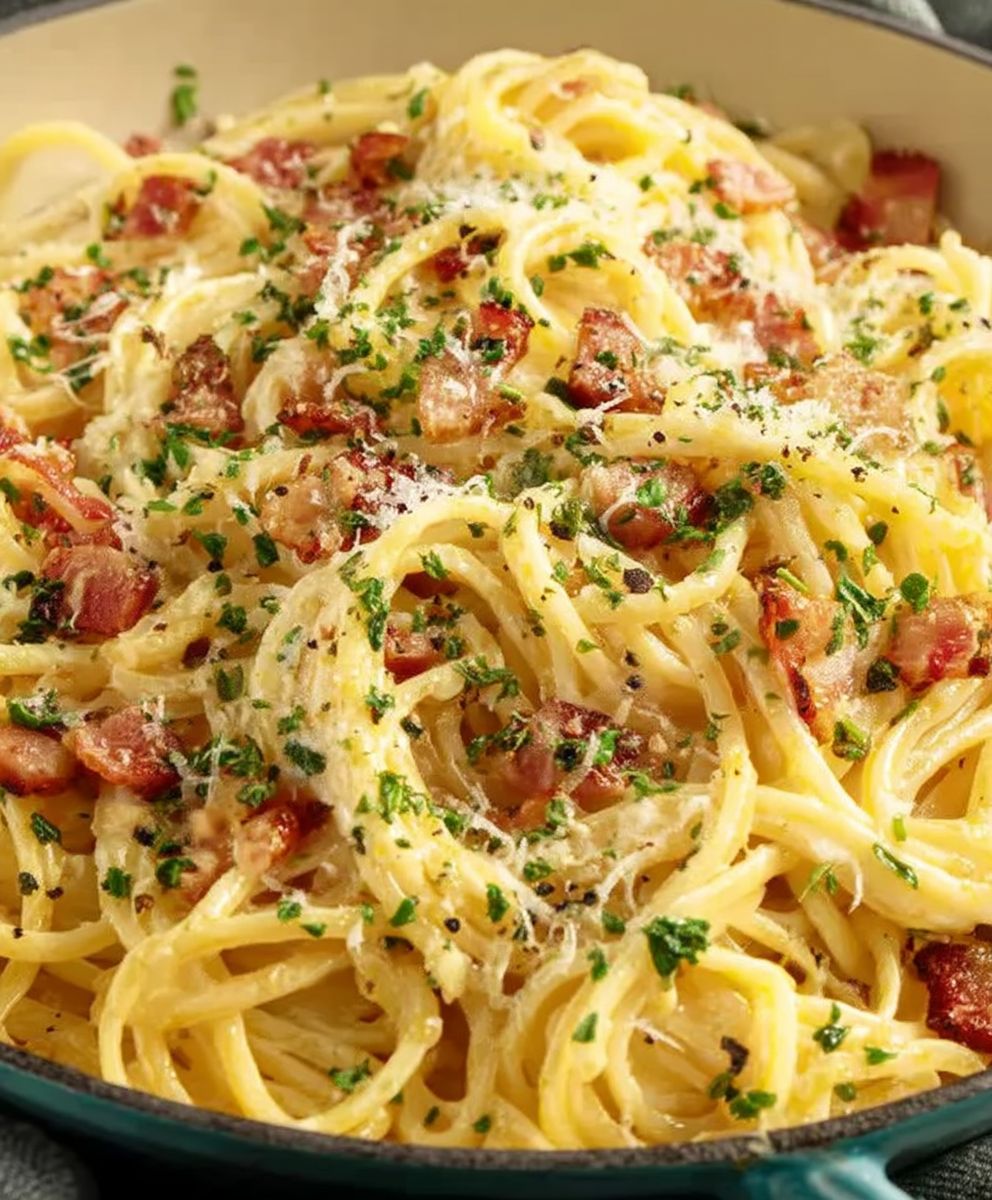
Conclusion:
So, there you have it! This isn’t just another pasta dish; it’s a journey to Italy in a bowl. The creamy, rich sauce clinging to perfectly cooked pasta, punctuated by salty pancetta and the subtle bite of black pepper it’s an experience you absolutely must try. I truly believe this pasta carbonara recipe will become a staple in your kitchen, a go-to for weeknight dinners or a special occasion that calls for something truly comforting and delicious.
But why is this recipe a must-try, you ask? Well, beyond the incredible flavor profile, it’s surprisingly simple to make. Forget complicated sauces and hours spent slaving over the stove. This recipe uses just a handful of high-quality ingredients and comes together in under 30 minutes. It’s the perfect balance of effort and reward, delivering restaurant-quality results with minimal fuss. Plus, mastering this classic dish opens the door to endless culinary possibilities.
And speaking of possibilities, let’s talk serving suggestions and variations! While I personally adore this recipe in its purest form, there’s always room for a little creativity. For a vegetarian twist, try substituting the pancetta with sautéed mushrooms or roasted vegetables like asparagus or zucchini. A sprinkle of fresh parsley or chives adds a vibrant pop of color and freshness. If you’re feeling adventurous, a dash of red pepper flakes can introduce a subtle heat that complements the richness of the sauce beautifully.
For serving, I love pairing this pasta carbonara with a simple side salad dressed with a light vinaigrette. The acidity of the salad cuts through the richness of the pasta, creating a perfectly balanced meal. A crusty loaf of bread is also a must for soaking up every last drop of that delicious sauce. And don’t forget the wine! A crisp, dry white wine like Pinot Grigio or Sauvignon Blanc is the perfect accompaniment.
But the real magic of this recipe lies in its ability to be adapted to your own personal preferences. Don’t be afraid to experiment with different types of pasta, cheeses, or even add-ins. The key is to start with a solid foundation this recipe and then let your creativity run wild.
I’m so confident that you’ll love this pasta carbonara recipe that I urge you to try it this week. Gather your ingredients, follow the simple steps, and prepare to be amazed. And most importantly, don’t forget to share your experience! I’d love to hear your thoughts, see your creations, and learn about any variations you’ve tried. Tag me in your photos on social media, leave a comment below, or send me an email. I’m always eager to connect with fellow food lovers and hear about your culinary adventures.
So, what are you waiting for? Get cooking! I promise you won’t regret it. This pasta carbonara is more than just a recipe; it’s an invitation to create memories, share delicious food with loved ones, and experience the joy of cooking. Happy cooking, and Buon Appetito!
Pasta Carbonara: The Authentic Recipe You Need to Try
Authentic Italian Spaghetti Carbonara made with guanciale, eggs, Pecorino Romano, and black pepper. A rich and creamy pasta dish ready in under 30 minutes!
Ingredients
- 1 pound spaghetti
- 6 ounces guanciale, pancetta, or bacon, cut into 1/4-inch dice
- 4 large eggs
- 1 cup grated Pecorino Romano cheese, plus more for serving
- 1/2 cup grated Parmesan cheese
- Freshly ground black pepper, to taste
- Salt, to taste (be mindful of the saltiness of the guanciale/pancetta/bacon)
- 2 tablespoons olive oil (optional, if guanciale/pancetta/bacon is lean)
Instructions
- In a large skillet or Dutch oven over medium heat, cook the diced guanciale, pancetta, or bacon until golden brown and crispy (8-12 minutes). If using lean bacon, add 1-2 tablespoons of olive oil to the pan.
- Remove the crispy pork with a slotted spoon and set aside. Reserve the rendered fat in the pan (about 2-3 tablespoons).
- In a medium bowl, separate the yolks from the 4 eggs. Add the grated Pecorino Romano and Parmesan cheese to the bowl with the egg yolks.
- Generously grind fresh black pepper into the egg and cheese mixture (about 1-2 teaspoons). Whisk thoroughly until you have a smooth, thick paste.
- Bring a large pot of salted water to a rolling boil. Add the spaghetti and cook according to package directions until al dente.
- Before draining the pasta, reserve 1-2 cups of the starchy pasta water.
- Drain the pasta in a colander (do not rinse).
- Immediately add the drained pasta to the skillet with the reserved pork fat. Toss to coat.
- Remove the skillet from the heat.
- Pour the egg and cheese mixture over the hot pasta.
- Quickly and vigorously toss the pasta with the egg and cheese mixture. If the sauce seems too thick, add a little of the reserved pasta water, a tablespoon at a time, until it reaches your desired consistency.
- Add the crispy guanciale, pancetta, or bacon to the pasta and toss to combine.
- Taste and season with salt and freshly ground black pepper as needed.
- Serve immediately, garnished with extra grated Pecorino Romano cheese and freshly ground black pepper.
Notes
- Use high-quality ingredients for the best flavor.
- Don’t overcook the pasta; cook it al dente.
- Reserving pasta water is crucial for a creamy sauce.
- Work quickly to prevent scrambled eggs.
- Adjust the sauce consistency with pasta water or cheese.
- Serve immediately for the best taste.
- Troubleshooting:
- Scrambled Eggs: Remove the pan from the heat completely before adding the egg mixture.
- Dry Sauce: Add more pasta water.
- Oily Sauce: Pour off some of the rendered fat before adding the pasta.

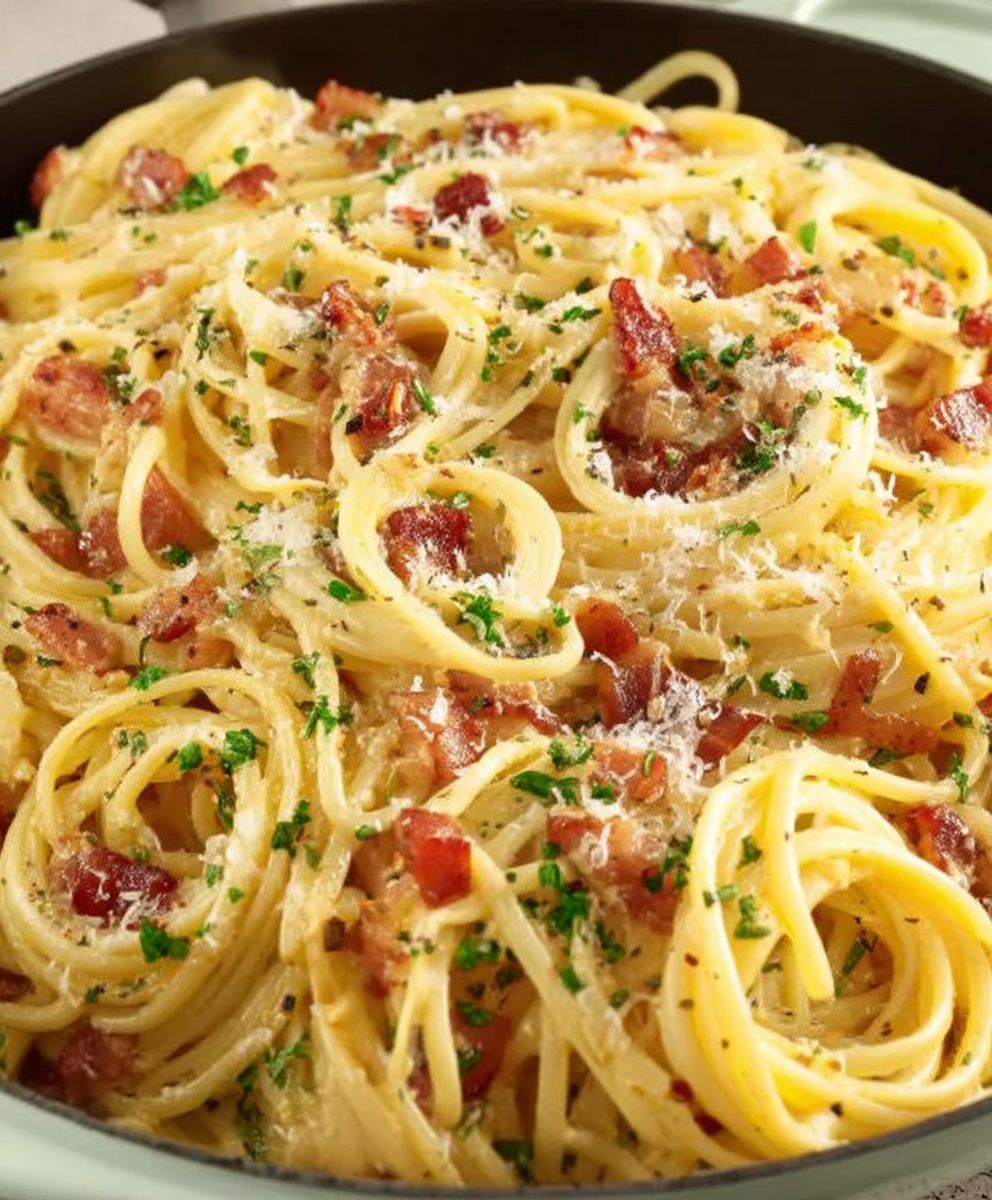
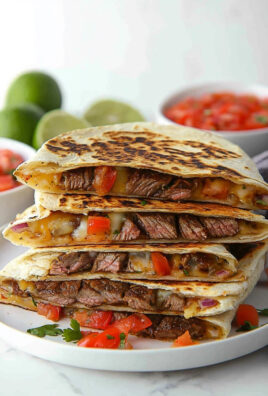
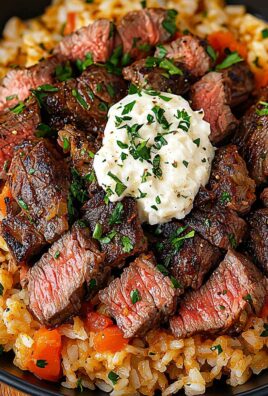
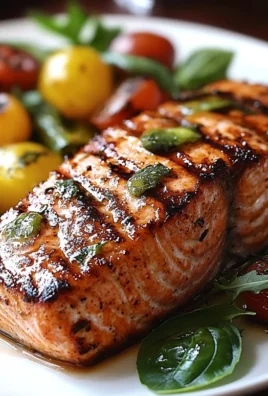
Leave a Comment